By Liz Stevens, writer, Plastics Business
The robots aren’t coming; they already are here. Automation in the form of robotic arms has been around for decades for factory work, and autonomous mobile robots are becoming widespread in manufacturing. Humanoid robots are the next incarnation of automation and they, too, are touted as helpful additions to the plant floor workforce.
A recent article, “Robotics and automation in plastic and rubber products manufacturing: How to get started,” 1 from the Business Development Bank of Canada (BDC), lays out information for Canadian manufacturers that has corollaries for US manufacturers. For plastics and rubber product manufacturers looking to remain competitive, implement imaginative solutions to workforce shortages and bolster strong ESG reputations, the BDC suggests that the top three applications for robotic automation are to automate plastic molding, material removal and sorting and assembly. “Automated plastic molding systems combine loading and unloading robots with molding machines to manufacture plastic products without needing continuous human intervention,” write the authors. “The loading and unloading robots are generally guided by sophisticated algorithms and can load or unload the molding machines consistently, without risking damage to the workpiece.”
As to material removal, the authors explain that “Material removal robots handle a range of tasks, such as cutting, trimming, drilling and deflashing.” Acknowledging that human employees certainly can perform these tasks by hand, “material removal robots are quicker and more precise than humans. Whether you manufacture toboggans, car components, computer covers or speaker enclosures, these machines will help achieve consistent product quality, increase production speed and optimize human resources.” Regarding sorting and assembly, the authors explain, “Sorting robots are used to separate and organize components, for instance, on a conveyor belt, in order to package them or assemble a final product. Assembly robots, on the other hand, are used to joint and fasten parts and components by welding, clipping, gluing or riveting them together.” Sorting robots, say the authors, help minimize production errors and increase production line speed while assembly robots enhance assembly consistency and relieve human workers of repetitive motions that can lead to stress injuries.
For an idea of the status of robotic arms and humanoid robots, here is a brief look at 10 robots for Industry 4.0 and advanced manufacturing.
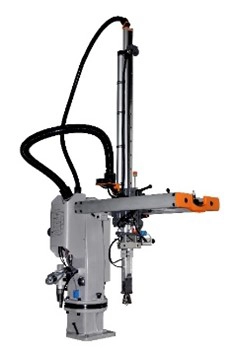
Absolute Robot
Absolute Robot Inc., Worcester, Massachusetts, is part of the Absolute Group of Companies and became its own division within Absolute in 2013. The company carries full servo 3- and 5-axis top-entry robots, sprue pickers and 6-axis FANUC robots. Absolute Robot can design a full automation cell, including end-of-arm-tooling, custom downstream equipment and other equipment that molders may use.
The company’s pneumatic sprue pickers come in the X and XW series. The X series has a single-stage arm and is geared for small-tonnage applications and low-overhead restriction. The XW series has a telescoping arm and increased payload for larger presses. Full servo robots from Absolute Robot include 3- and 5-axis robots programmable for part removal, inserting, palletizing, stacking and more, with an intuitive and easy-to-program controller. Absolute Robot is a FANUC-authorized system integrator, with the capability to automate a single machine or an entire facility.

Apollo
Apollo is a humanoid robot produced by Apptronik, of Austin, Texas. The robot can be fully mobile with legs for walking, mounted as a torso, head and arms unit on a mobile platform or positioned as a stationary machine. Apptronik describes Apollo as designed for friendly interaction, as well as for mass manufacturability, high payloads and safety. The company states that Apollo’s current abilities are geared toward warehousing and manufacturing applications, with features for other areas of industry and commerce to be addressed in the future.
Carmaker Mercedes-Benz has begun trials of the Apollo humanoid robot. According to the article “Robots Transform Manufacturing,” 2 Mercedes-Benz has collaborated with Apptronik to design and produce AI robotics for integration into manufacturing environments to automate physically demanding tasks. “One of the key highlights of this collaboration,” write the authors, “is the remarkable agility and adaptability of the Apollo robots. They can navigate complex environments, manipulate objects with precision and perform intricate tasks with ease.”
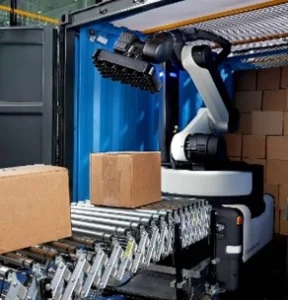
Boston Dynamics
Spot, a dog-like quadruped, and Stretch, a cobot arm with a mobile platform, are from Waltham, Massachusetts-based Boston Dynamics. Spot is an agile robot with advanced sensing features, touted by the company as a robot that “provides valuable insights into routine operations, site health or potentially hazardous situations.” Stretch is a mobile platform with a cobot arm mounted on it. According to the company website, Stretch excels at moving items, and “offers predictability for warehouse operations, working continuously and keeping the flow of goods moving.” Boston Dynamics also has a humanoid robot, Atlas, which was a hydraulic biped that now is being redeveloped into an all-electric version.
In the article “5 Companies Working on Humanoid Robots,” 3 author Keyede Erinfolami writes the following in describing the Atlas robot: “Thanks to a 360-degree swivel head that might remind you of the Pixar lamp, and similar 360-degree joints, the all-new Atlas can walk both forward and backward, and do bends and flips.” This flexibility allows Atlas to complete tasks more efficiently by virtue of having a range of motion greater than a human. “The electric shapeshifter will retain all the capabilities that HD [hydraulic] Atlas had, including lifting and maneuvering objects, but will also explore ‘several new gripper variations’ to make it suitable for work in different industries.”
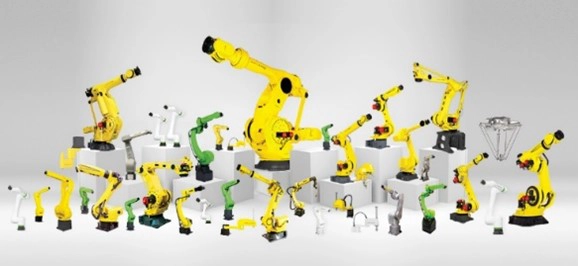
FANUC
FANUC America, Rochester Hills, Michigan, has been in business since the inception of its parent company in Japan in 1956. FANUC has a wide field of robotic arms in more than a dozen product lines. The company’s robots are designed for assembly, welding, pick-pack-palletizing, loading/transferring, material removal, dispensing and painting/coating.
The Plastics Business article “Beacon Engineered Solutions Implements Automation to Ease Labor Crunch” 4 describes some of the tasks that injection molder Beacon Engineered Solutions has turned over to robots. The company – which has nearly 2,000 active molds – has implemented a variety of robots/cobots, including a FANUC CRX10 cobot, since launching its first automation project in 2008.
ASYST Automation, Kenosha, Wisconsin, is an authorized system integrator of FANUC robots. The company offers custom automation system solutions, including vision systems, operator interfaces, PC and PLC control systems and much more for automotive, consumer products, injection molding, medical, electronics and pharmaceuticals. The company automates processes such as assembly, inspection, ultrasonic welding, pressure testing and packaging.
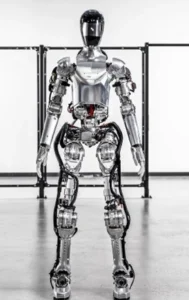
Figure
Sunnyvale, California-based robotics company Figure created Figure 01, a humanoid robot, as a general-purpose robot. Per the Figure website, “With one product we can meet the complex human environment with human-like capabilities, and provide endless types of support across a variety of circumstances.” This young company’s first application of its technology is slated for industries such as manufacturing, shipping and logistics, warehousing and retail, where labor shortages are the most severe. “In early development, the tasks humanoids complete will be structured and repetitive, but over time, and with advancements in robot learning and software, humanoids will expand in capability and be able to tackle more complex job functions.”
Under an agreement between automaker BMW and Figure, BMW plans to bring Figure 01 humanoid robots to its manufacturing facilities for real-world investigation of the robot’s capabilities and its value for automobile manufacturers. 5 In “5 Companies Working on Humanoid Robots,” 3 author Erinfolami writes that Figure, founded in 2022, acknowledges that its vision for Figure 01 will require time to be realized. It will take time for humanoid robots to be able to mimic the complex functionality of the human body, CTO Jerry Pratt told IEEE Spectrum, but the goal is to get as close as possible. The company also has announced a partnership with ChatGPT’s creator, OpenAI, to use the company’s large language model to make its robot smart, interactive and self-reliant.
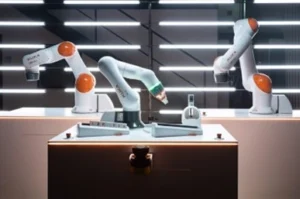
Kuka
Industry veteran Kuka, Augsburg, Germany, was founded in 1898. In 1973, the company created the world’s first industrial robot with six electric-motor-driven axes. Kuka now offers a wide variety of fixed robotic arms and autonomous mobile robotics.
In gearing its robotics for the plastics manufacturing industry, Kuka has machines designed for assembly, handling, machine loading/unloading, machining, measuring/inspection, applying/painting/gluing, additive manufacture and 3D printing, palletizing/packaging and pick-and-place.
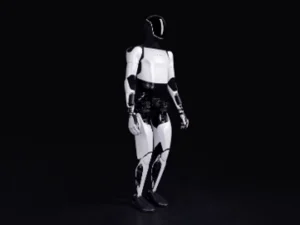
Tesla
Automaker Tesla, Austin, Texas, is planning to rev up the automation sector with Optimus, a humanoid robot. Optimus is a general-purpose autonomous biped robot being developed to perform unsafe, repetitive or boring tasks, with advanced dexterous manipulation abilities. While this product still is in the final design/refine stages, Tesla and CEO Elon Musk are dropping hints about what capabilities the robot will offer, like walking, squatting, balancing, lifting and sorting.
Per “5 Companies Working on Humanoid Robots,” 3 Optimus “is designed to take over dangerous and repetitive tasks from humans, with its potential use cases ranging from logistics and factory work to assisting around the house.” The article also states that Tesla aims to perfect the robot’s functionality enough by year-end 2024 for it to handle some factory jobs, and to be available on the market by the end of 2025.
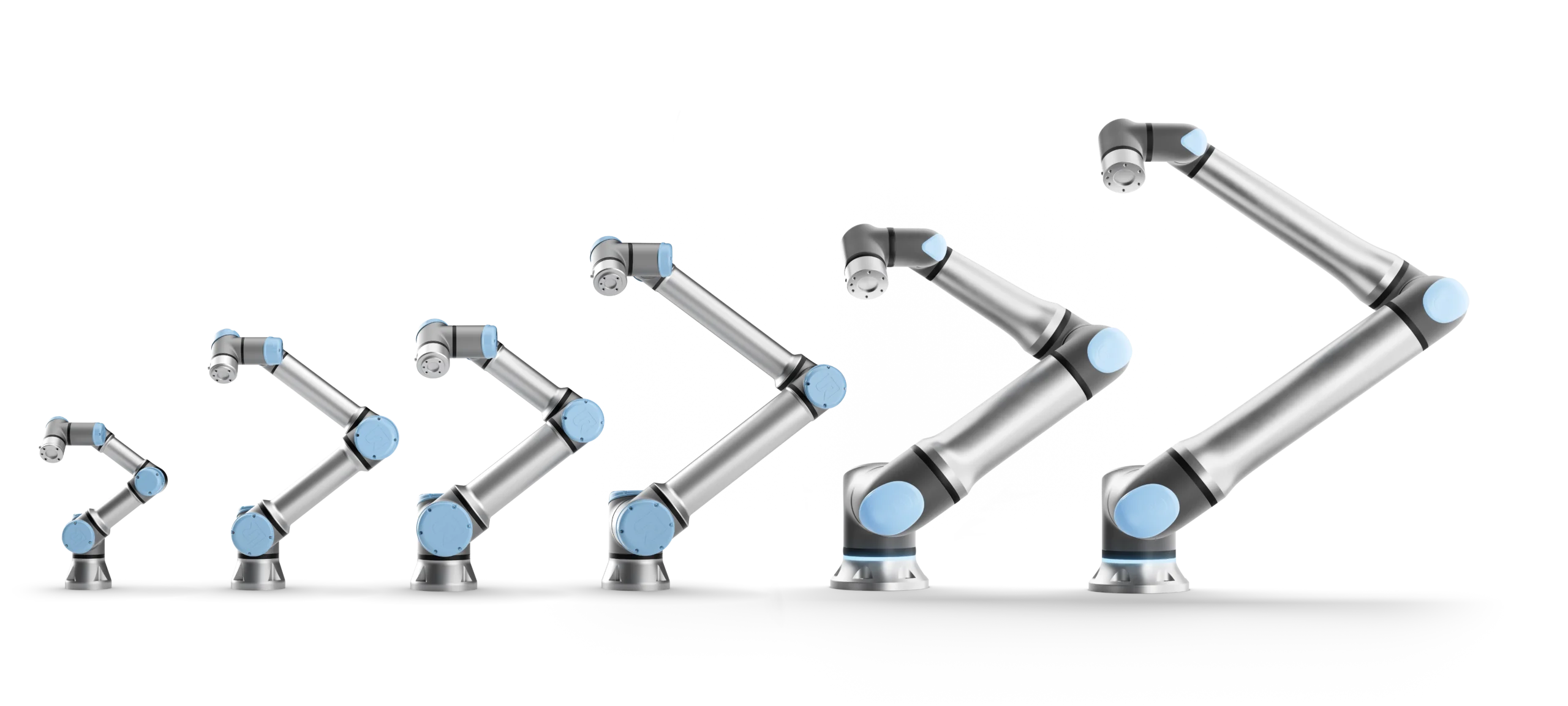
Universal
Universal, of Odense, Denmark, has been designing and refining its lineup of robot-cobots since 2005, and now offers a wide field of compact, lightweight, adaptable, flexible robotic arms for superior motion control and fast speeds, with a variety of payload and reach options.
In “Beacon Engineered Solutions Implements Automation to Ease Labor Crunch,” 4 Plastics Business described some of the tasks that injection molder Beacon Engineered Solutions has turned over to robots. The company has implemented several Universal UR5 and UR10 robots, since it launched its first automation project in 2008.
A 2024 article from The Robot Report, “Cobot creates ‘cell manufacturing dream’ for plastics thermoformer,” 6 details a plastics thermoformer that implemented a Universal UR10e collaborative robot to handle the complex trimming task on items produced in a four-cavity mold. Very pleased with the results, the thermoformer now is considering using cobots as much as possible in the form-trim-palletize stages of production.

Yaskawa
Founded in 1989, Yaskawa America, Waukegan, Illinois, has a product line of more than 150 distinct industrial arm, delta and SCARA robot models, plus a full line of pre-engineered “world” solutions that are complete application-specific robotic systems. Yaskawa’s robotic arms and SCARA robotic arms are high-payload, high-speed, extended-reach, maneuverable robotic arms for assembly and handling, welding and cutting, painting and dispensing.
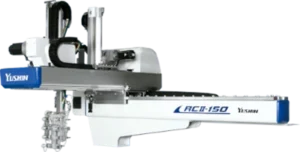
YUSHIN
YUSHIN AMERICA, INC., Cranston, Rhode Island, established in 1988, is the oldest and largest subsidiary company of Japan’s Yushin Precision Equipment Co. The company offers a wide range of individual robots, fully integrated factory automation, end-of-arm tools, conveyors and safety guarding for the plastics molding industry.
YUSHIN’s product line includes more than 100 robot models. The OB7 7-axis collaborative robot requires no programming: The cobot “learns” by being shown how to do a task such as machine tending, packaging, gluing, painting and welding, and QC tasks. YUSHIN’s line of high-end-take-out robots – the RC/RCII line – is designed with speed, reliability and savings in mind. The RCII series features enhanced rigidity, robust construction and vibration suppression on EAOTs.
The robots aren’t coming; they already are here. Need a hand on the plant floor? There are a lot of options out there.
More information: www.absoluterobot.com, www.apptronik.com/apollo, www.bostondynamics.com, www.fanucamerica.com, www.asystautomation.com, www.figure.ai, www.kuka.com, www.tesla.com, www.universal-robots.com, www.motoman.com, www.yushinamerica.com
References
- Business Development Bank of Canada. “Robotics and automation in plastic and rubber products manufacturing: How to get started.” www.bdc.ca/en/articles-tools/operations/operational-efficiency/robotics-and-automation-in-plastic-and-rubber-products-manufacturing-how-get-started.
- Interesting Engineering. “Robots Transform Manufacturing.” www.interestingengineering.com/videos/50207.
- Keyede Erinfolami. “5 Companies Working On Humanoid Robots.” SlashGear.com. May 26, 2024. www.slashgear.com/1586302/companies-that-are-working-on-humanoid-robots/.
- Liz Stevens. “Beacon Engineered Solutions Implements Automation to Ease Labor Crunch.” Plastics Business. 2024, Issue 2. www.bluetoad.com/publcation/?m=18060&i=821758&p=6&pre=1&ver=html5.
- Mack DeGeurin. “BMW plans to put humanoid robots in a South Carolina factory to do… something.” Popular Science. January 23, 2024. www.popsci.com/technology/bmw-humanoid-robot/.
- The Robot Report Staff. “Cobot creates ‘cell manufacturing dream’ for plastics thermoformer.” February 2, 2024. www.therobotreport.com/cobot-creates-cell-manufacturing-dream-for-plastics-thermoformer/.



